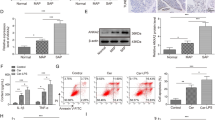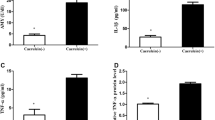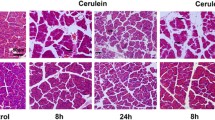Abstract
The purpose of the present study is to investigate the role of CREB in cardiomyocytes proliferation in regulation of HDAC2-dependent TLR4/NF-κB pathway in severe acute pancreatitis (SAP)-induced myocardial injury. The SAP rat model was developed by injecting sodium touracholate into SD rats and then infected with lentivirus vectors expressing sh-CREB in the presence/absence of LPS. The pathological alterations of rat pancreatic and cardiac tissues were observed by HE staining. TUNEL assay was used to study apoptosis of cardiomyocytes. Next, the loss- and gain-function assay was conducted in LPS-induced myocardial injury cardiomyocytes to define the roles of CREB, HDAC2, and TLR4 in cardiomyocyte proliferation, apoptosis, inflammation, and myocardial injury in vitro. ChIP assay was used to study the enrichment of CREB bound to HDAC2 promoter. RT-qPCR and Western blot analysis were used to detect the expressions of related mRNA and proteins in the NF-κB pathway, respectively. CREB was found to be overexpressed in both SAP tissues and cells. CREB directly bound to the promoter of HDAC2 and activated its expression. Overexpressed CREB or HDAC2 inhibited proliferation and promoted apoptosis of cardiomyocytes. Suppression of CREB inhibited the HDAC2/TLR4/NF-κB cascade to promote proliferation and inhibit apoptosis of cardiomyocytes. The in vitro results were validated in vivo experiments. Coherently, suppression of CREB can inhibit HDAC2/TLR4/NF-κB cascade to promote cardiomyocyte proliferation, thus ameliorating SAP-induced myocardial injury.








Similar content being viewed by others
Data Availability
The data sets used and/or analyzed during the current study are available from the corresponding author on reasonable request.
Change history
15 February 2024
This article has been retracted. Please see the Retraction Notice for more detail: https://doi.org/10.1007/s10753-024-01987-7
References
Gill, P., and A.H. Amree. 2019. Allele-specific loop-mediated isothermal amplification for the detection of IVSII-I G>A Mutation On beta-Globin Gene. Open Access Macedonian Journal of Medical Sciences 7 (10): 1582–1587.
Zerem, E. 2014. Treatment of severe acute pancreatitis and its complications. World Journal of Gastroenterology 20 (38): 13879–13892.
Yegneswaran, B., J.B. Kostis, and C.S. Pitchumoni. 2011. Cardiovascular manifestations of acute pancreatitis. Journal of Critical Care 26 (2): 225 e211–225 e228.
Xiping, Z., T. Hua, C. Hanqing, C. Li, W. Zhiwei, W. Keyi, Y. Wei, L. Yun, L. Qingyu, H. Qing, and W. Fei. 2007. The protecting effects and mechanisms of baicalin and octreotide on heart injury in rats with SAP. Mediators of Inflammation 2007: 19469.
Li, L., Y.Q. Li, Z.W. Sun, C.M. Xu, J. Wu, G.L. Liu, A.M. Bakheet, and H.L. Chen. 2020. Qingyi decoction protects against myocardial injuries induced by severe acute pancreatitis. World Journal of Gastroenterology 26 (12): 1317–1328.
Portelli, M., and C.D. Jones. 2017. Severe acute pancreatitis: pathogenesis, diagnosis and surgical management. Hepatobiliary & Pancreatic Diseases International 16 (2): 155–159.
Habtezion, A., A.S. Gukovskaya, and S.J. Pandol. 2019. Acute pancreatitis: a multifaceted set of organelle and cellular interactions. Gastroenterology 156 (7): 1941–1950.
Feng, W., R. Teng, Y. Zhao, J. Gao, and H. Chu. 2015. Epigenetic modulation of Wnt signaling contributes to neuropathic pain in rats. Molecular Medicine Reports 12 (3): 4727–4733.
Ma, X., D. Wu, S. Zhou, F. Wan, H. Liu, X. Xu, X. Xu, Y. Zhao, and M. Tang. 2016. The pancreatic cancer secreted REG4 promotes macrophage polarization to M2 through EGFR/AKT/CREB pathway. Oncology Reports 35 (1): 189–196.
Chan, Y.C., and P.S. Leung. 2009. Involvement of redox-sensitive extracellular-regulated kinases in angiotensin II-induced interleukin-6 expression in pancreatic acinar cells. The Journal of Pharmacology and Experimental Therapeutics 329 (2): 450–458.
Toussirot, E., D. Wendling, G. Herbein, and Cic. 2014. Biological treatments given in patients with rheumatoid arthritis or ankylosing spondylitis modify HAT/HDAC (histone acetyltransferase/histone deacetylase) balance. Joint, Bone, Spine 81 (6): 544–545.
Guo, P., W. Chen, H. Li, M. Li, and L. Li. 2018. The histone acetylation modifications of breast cancer and their therapeutic implications. Pathology Oncology Research 24 (4): 807–813.
Liao, Y.H., J. Wang, Y.Y. Wei, T. Zhang, Y. Zhang, Z.F. Zuo, X.Y. Teng, and Y.Q. Li. 2018. Histone deacetylase 2 is involved in microopioid receptor suppression in the spinal dorsal horn in a rat model of chronic pancreatitis pain. Molecular Medicine Reports 17 (2): 2803–2810.
Jahan, S., J.M. Sun, S. He, and J.R. Davie. 2018. Transcription-dependent association of HDAC2 with active chromatin. Journal of Cellular Physiology 233 (2): 1650–1657.
Jiao, F.Z., Y. Wang, H.Y. Zhang, W.B. Zhang, L.W. Wang, and Z.J. Gong. 2018. Histone deacetylase 2 inhibitor CAY10683 alleviates lipopolysaccharide induced neuroinflammation through attenuating TLR4/NF-kappaB signaling pathway. Neurochemical Research 43 (6): 1161–1170.
Hong, Y.P., J. Yu, Y.R. Su, F.C. Mei, M. Li, K.L. Zhao, L. Zhao, W.H. Deng, C. Chen, and W.X. Wang. 2020. High-fat diet aggravates acute pancreatitis via TLR4-mediated necroptosis and inflammation in rats. Oxidative Medicine and Cellular Longevity 2020: 8172714.
Jakkampudi, A., R. Jangala, B.R. Reddy, S. Mitnala, D. Nageshwar Reddy, and R. Talukdar. 2016. NF-kappaB in acute pancreatitis: mechanisms and therapeutic potential. Pancreatology 16 (4): 477–488.
Liu, Z., J. Liu, K. Zhao, Q. Shi, T. Zuo, G. Wang, and W. Wang. 2016. Role of daphnetin in rat severe acute pancreatitis through the regulation of TLR4/NF-[formula: see text]B signaling pathway activation. The American Journal of Chinese Medicine 44 (1): 149–163.
Li, L., Z. Sun, C. Xu, J. Wu, G. Liu, H. Cui, and H. Chen. 2018. Adenovirus-mediated overexpression of sST2 attenuates cardiac injury in the rat with severe acute pancreatitis. Life Sciences 202: 167–174.
Wang, Y., and M. Chen. 2017. Fentanyl ameliorates severe acute pancreatitis-induced myocardial injury in rats by regulating NF-kappaB signaling pathway. Medical Science Monitor 23: 3276–3283.
Wu, J., J. Wang, X. Li, X. Liu, X. Yu, and Y. Tian. 2017. MicroRNA-145 Mediates the formation of angiotensin II-induced murine abdominal aortic aneurysm. Heart, Lung & Circulation 26 (6): 619–626.
Ayuk, S.M., H. Abrahamse, and N.N. Houreld. 2016. The role of photobiomodulation on gene expression of cell adhesion molecules in diabetic wounded fibroblasts in vitro. Journal of Photochemistry and Photobiology. B 161: 368–374.
Al-Wadei, H.A., M.H. Al-Wadei, and H.M. Schuller. 2009. Prevention of pancreatic cancer by the beta-blocker propranolol. Anti-Cancer Drugs 20 (6): 477–482.
Hulsurkar, M., Z. Li, Y. Zhang, X. Li, D. Zheng, and W. Li. 2017. Beta-adrenergic signaling promotes tumor angiogenesis and prostate cancer progression through HDAC2-mediated suppression of thrombospondin-1. Oncogene 36 (11): 1525–1536.
Tang, D., Y.C. Zhao, D. Qian, H. Liu, S. Luo, E.F. Patz, P.G. Moorman, L. Su, S. Shen, D.C. Christiani, C. Glass, W. Gao, and Q. Wei. 2020. Novel genetic variants in HDAC2 and PPARGC1A of the CREB-binding protein pathway predict survival of non-small-cell lung cancer. Molecular Carcinogenesis 59 (1): 104–115.
Sandoval, J., J. Pereda, J.L. Rodriguez, J. Escobar, J. Hidalgo, L.A. Joosten, L. Franco, J. Sastre, and G. Lopez-Rodas. 2010. Ordered transcriptional factor recruitment and epigenetic regulation of tnf-alpha in necrotizing acute pancreatitis. Cellular and Molecular Life Sciences 67 (10): 1687–1697.
Ouaissi, M., F. Silvy, C. Loncle, D. Ferraz da Silva, C. Martins Abreu, E. Martinez, P. Berthezene, S. Cadra, Y.P. Le Treut, J. Hardwigsen, B. Sastre, I. Sielezneff, L. Benkoel, J. Delgrande, A. Ouaissi, J. Iovanna, D. Lombardo, and E. Mas. 2014. Further characterization of HDAC and SIRT gene expression patterns in pancreatic cancer and their relation to disease outcome. PLoS One 9 (9): e108520.
Sandoval, J., J. Pereda, S. Perez, I. Finamor, A. Vallet-Sanchez, J.L. Rodriguez, L. Franco, J. Sastre, and G. Lopez-Rodas. 2016. Epigenetic regulation of early- and late-response genes in acute pancreatitis. Journal of Immunology 197 (10): 4137–4150.
John, S.P., J. Sun, R.J. Carlson, B. Cao, C.J. Bradfield, J. Song, M. Smelkinson, and I.D.C. Fraser. 2018. IFIT1 exerts opposing regulatory effects on the inflammatory and interferon gene programs in LPS-activated human macrophages. Cell Reports 25 (1): 95–106 e106.
Wang, Y., H. Chen, Q. Chen, F.Z. Jiao, W.B. Zhang, and Z.J. Gong. 2018. The protective mechanism of CAY10683 on intestinal mucosal barrier in acute liver failure through LPS/TLR4/MyD88 pathway. Mediators of Inflammation 2018: 7859601.
Du, P., K. Gao, Y. Cao, S. Yang, Y. Wang, R. Guo, M. Zhao, and S. Jia. 2019. RFX1 downregulation contributes to TLR4 overexpression in CD14(+) monocytes via epigenetic mechanisms in coronary artery disease. Clinical Epigenetics 11 (1): 44.
Pan, L.F., L. Yu, L.M. Wang, J.T. He, J.L. Sun, X.B. Wang, H. Wang, Z.H. Bai, H. Feng, and H.H. Pei. 2018. Augmenter of liver regeneration (ALR) regulates acute pancreatitis via inhibiting HMGB1/TLR4/NF-kappaB signaling pathway. American Journal of Translational Research 10 (2): 402–410.
Li, G., X. Wu, L. Yang, Y. He, Y. Liu, X. Jin, and H. Yuan. 2016. TLR4-mediated NF-kappaB signaling pathway mediates HMGB1-induced pancreatic injury in mice with severe acute pancreatitis. International Journal of Molecular Medicine 37 (1): 99–107.
Wang, B., X.B. Xu, X.X. Jin, X.W. Wu, M.L. Li, M.X. Guo, and X.H. Zhang. 2017. Effects of omega-3 fatty acids on toll-like receptor 4 and nuclear factor kappaB p56 in the pancreas of rats with severe acute pancreatitis. Pancreas 46 (10): 1267–1274.
Su, S., T. Liang, X. Zhou, K. He, B. Li, and X. Xia. 2019. Qingyi decoction attenuates severe acute pancreatitis in rats via inhibition of inflammation and protection of the intestinal barrier. The Journal of International Medical Research 47 (5): 2215–2227.
Wang, J., C. Zhang, P. Xu, Z.W. Yang, C.Z. Weng, and Y.X. Lai. 2018. Phosphoinositide 3kinase/protein kinase B regulates inflammation severity via signaling of tolllike receptor 4 in severe acute pancreatitis. Molecular Medicine Reports 17 (6): 7835–7844.
Kylanpaa, L., Z. Rakonczay Jr., and D.A. O'Reilly. 2012. The clinical course of acute pancreatitis and the inflammatory mediators that drive it. International Journal of Inflammation 2012: 360685.
Escobar, J., J. Pereda, A. Arduini, J. Sandoval, L. Sabater, L. Aparisi, G. Lopez-Rodas, and J. Sastre. 2010. Protein phosphatases and chromatin modifying complexes in the inflammatory cascade in acute pancreatitis. World Journal of Gastrointestinal Pharmacology and Therapeutics 1 (3): 75–80.
Lim, B., K. Jung, Y. Gwon, J.G. Oh, J.I. Roh, S.H. Hong, C. Kho, W.J. Park, H.W. Lee, J.W. Bae, and Y.K. Jung. 2019. Cardioprotective role of APIP in myocardial infarction through ADORA2B. Cell Death & Disease 10 (7): 511.
Zhang, B., P. Zhang, Y. Tan, P. Feng, Z. Zhang, H. Liang, W. Duan, Z. Jin, X. Wang, J. Liu, E. Gao, S. Yu, D. Yi, Y. Sun, and W. Yi. 2019. C1q-TNF-related protein-3 attenuates pressure overload-induced cardiac hypertrophy by suppressing the p38/CREB pathway and p38-induced ER stress. Cell Death & Disease 10 (7): 520.
Wullaert, A. 2010. Role of NF-kappaB activation in intestinal immune homeostasis. International Journal of Medical Microbiology 300 (1): 49–56.
Noreen, M., M.A. Shah, S.M. Mall, S. Choudhary, T. Hussain, I. Ahmed, S.F. Jalil, and M.I. Raza. 2012. TLR4 polymorphisms and disease susceptibility. Inflammation Research 61 (3): 177–188.
Sharif, R., R. Dawra, K. Wasiluk, P. Phillips, V. Dudeja, E. Kurt-Jones, R. Finberg, and A. Saluja. 2009. Impact of toll-like receptor 4 on the severity of acute pancreatitis and pancreatitis-associated lung injury in mice. Gut 58 (6): 813–819.
Ding, S.Q., Y. Li, Z.G. Zhou, C. Wang, L. Zhan, and B. Zhou. 2010. Toll-like receptor 4-mediated apoptosis of pancreatic cells in cerulein-induced acute pancreatitis in mice. Hepatobiliary & Pancreatic Diseases International 9 (6): 645–650.
Sah, R.P., R.K. Dawra, and A.K. Saluja. 2013. New insights into the pathogenesis of pancreatitis. Current Opinion in Gastroenterology 29 (5): 523–530.
Yang, Z., Y. Deng, D. Su, J. Tian, Y. Gao, Z. He, and X. Wang. 2013. TLR4 as receptor for HMGB1-mediated acute lung injury after liver ischemia/reperfusion injury. Laboratory Investigation 93 (7): 792–800.
Su, Y.R., Y.P. Hong, F.C. Mei, C.Y. Wang, M. Li, Y. Zhou, K.L. Zhao, J. Yu, and W.X. Wang. 2019. High-fat diet aggravates the intestinal barrier injury via TLR4-RIP3 pathway in a rat model of severe acute pancreatitis. Mediators of Inflammation 2019: 2512687.
Lin, M., J. Huang, W.C. Chen, Z.N. Fan, and X. Qin. 2020. The immunomodulatory effects and mechanisms of Tim-3 action in the early stage of mice with severe acute pancreatitis. Iranian Journal of Immunology 17 (1): 52–63.
Zheng, J., L. Lou, J. Fan, C. Huang, Q. Mei, J. Wu, Y. Guo, Y. Lu, X. Wang, and Y. Zeng. 2019. Commensal Escherichia coli aggravates acute necrotizing pancreatitis through targeting of intestinal epithelial cells. Applied and Environmental Microbiology 85 (12).
Acknowledgements
We would like to acknowledge the reviewers for their helpful comments on this paper.
Funding
This work was supported by Scientific Research Fund Project of Shaanxi Provincial Health and Family Planning Commission (No. 2016D015), Science and Technology Planning Project of Xi’an (No. 2017113SF/YX007(15)), and Shaanxi Provincial Science and Technology Research Subject of Traditional Chinese Medicine (No. 2019-ZZ-JC031).
Author information
Authors and Affiliations
Contributions
(I) Conception and design: Longfei Pan, Zequn Niu, Yanxia Gao; (II) administrative support: Yanxia Gao, Liming Wang, Zhong Liu, Jie Liu; (III) provision of study materials: Jiangli Sun, Honghong Pei; (IV) collection and assembly of data: Longfei Pan, Zequn Niu, Yanxia Gao; (V) data analysis and interpretation: Longfei Pan, Zequn Niu, Jiangli Sun; (VI) manuscript writing: Zequn Niu, Yanxia Gao; (VII) final approval of manuscript: all authors.
Corresponding author
Ethics declarations
Ethics Approval and Consent to Participate
The study and procedures were complied with the Laboratory Animal Care and Use Guide (NIH Publication NO. 85-23, revised 2011). Animal study was approved by the laboratory animal care committee of Xi’an Jiaotong University.
Consent for Publication
Not applicable.
Competing Interests
The authors declare that they have no competing interest.
Additional information
Publisher’s Note
Springer Nature remains neutral with regard to jurisdictional claims in published maps and institutional affiliations.
This article has been retracted. Please see the retraction notice for more detail: https://doi.org/10.1007/s10753-024-01987-7"
Supplementary Information
ESM 1
(DOCX 16 kb)
Rights and permissions
Springer Nature or its licensor (e.g. a society or other partner) holds exclusive rights to this article under a publishing agreement with the author(s) or other rightsholder(s); author self-archiving of the accepted manuscript version of this article is solely governed by the terms of such publishing agreement and applicable law.
About this article
Cite this article
Pan, L., Niu, Z., Gao, Y. et al. RETRACTED ARTICLE: Silencing of CREB Inhibits HDAC2/TLR4/NF-κB Cascade to Relieve Severe Acute Pancreatitis-Induced Myocardial Injury. Inflammation 44, 1565–1580 (2021). https://doi.org/10.1007/s10753-021-01441-y
Received:
Revised:
Accepted:
Published:
Issue Date:
DOI: https://doi.org/10.1007/s10753-021-01441-y




